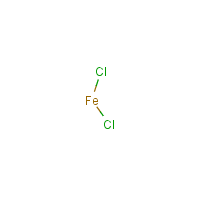Ferrous chloride
Agent Name
Ferrous chloride
CAS Number
7758-94-3
Formula
Cl2-Fe
Major Category
Metals

Synonyms
Ferro 66; Ferrous dichloride; Iron chloride (FeCl2); Iron dichloride; Iron protochloride; Iron(2+) chloride; Iron(II) chloride; Natural lawrencite; Ferrous chloride, solid; Ferrous chloride, solution; [ChemIDplus] UN1759; UN1760 (solution)
Category
Metals, Inorganic Compounds
Description
White to white-green crystals; [NIOSH] Highly hygroscopic white solid (may have a green tint); Soluble in water; [Merck Index] Light green odorless solid; [CHRIS] Off-white odorless powder; [Alfa Aesar MSDS]
Sources/Uses
Used as a reducing agent, a mordant in textile dyeing, a sludge dewatering agent in sewage treatment, in metallurgy, as a hot bath in iron plating, and to make pharmaceuticals and ferric chloride; [HSDB] Found in nature as the mineral lawrencite; [Merck Index]
Comments
Toxic by ingestion: 10 tablets (0.3 g Fe/tablet) causes mild illness in children; 20 tablets cause severe intoxication; Mortality rate was 1% in 474 acute iron poisoning cases; [ACGIH] Corrosive to skin; [Quick CPC] An irritant that may cause liver injury; [Merck Index] A skin, eye, nose, and throat irritant; [CHRIS] Causes burns; Harmful by ingestion; [Alfa Aesar MSDS] See "Iron salts, soluble."
Biomedical References
Exposure Assessment
Skin Designation (ACGIH)
Insufficient data
TLV (ACGIH)
1 mg/m3, as Fe (soluble iron salts)
Explanatory Notes
TLV is for "Iron salts, soluble"; [ACGIH] Melting point = 674 degrees C; [HSDB] The Guide in the Emergency Response Guidebook is for "Ferrous chloride, solid."
Adverse Effects
Hepatotoxin
Hepatoxic (a) from occupational exposure (secondary effect) or (b) in animal studies or in humans after ingestion
Dermatotoxin
Skin burns
Diseases, Processes, and Activities Linked to This Agent
Processes
Industrial Processes with risk of exposure: